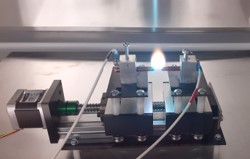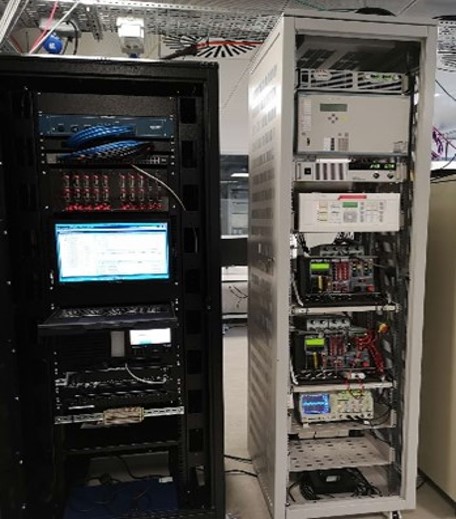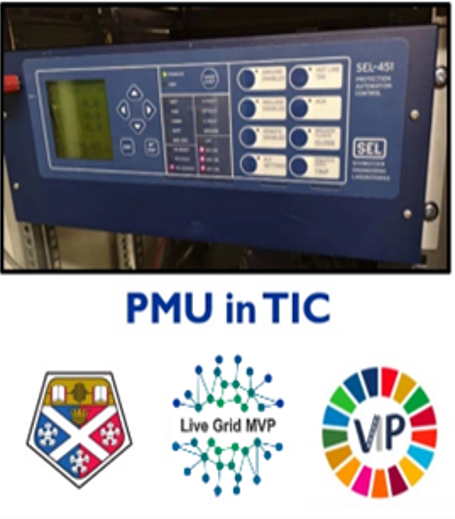We operate the Dynamic Power Systems Laboratory within the Technology and Innovation Centre in Glasgow's city centre. It is equipped with state-of-the-art experimental facilities to support both research and commercial activities relating to Smart Grids, including a microgrid laboratory with a 90 kVA three-phase power hardware-in-the-loop (PHIL) capability and a real-time simulation suite. Specific technologies underpinning the infrastructure include: fully-controllable Triphase power electronics units, a flexible 400 V network, a Real Time Digital Simulator (RTDS), real-time communications emulation, precision time-synchronisation, Phasor Measurement Units (PMUs), and modern protocols for data communications.
Academic lead: Prof Graeme Burt
Lab access: Access to the Dynamic Power Systems Laboratory for collaborative research work is available through the ERIGrid Transnational Access programme. This scheme provides funding for researchers and companies (especially SMEs) to travel to our laboratory and demonstrate innovative smart grid solutions, leveraging our experimental facilities and expertise. Please contact Zhiwang Feng for more information: zhiwang.feng@strath.ac.uk.
State-of-the-Art Testing Facilities & Active Research Areas
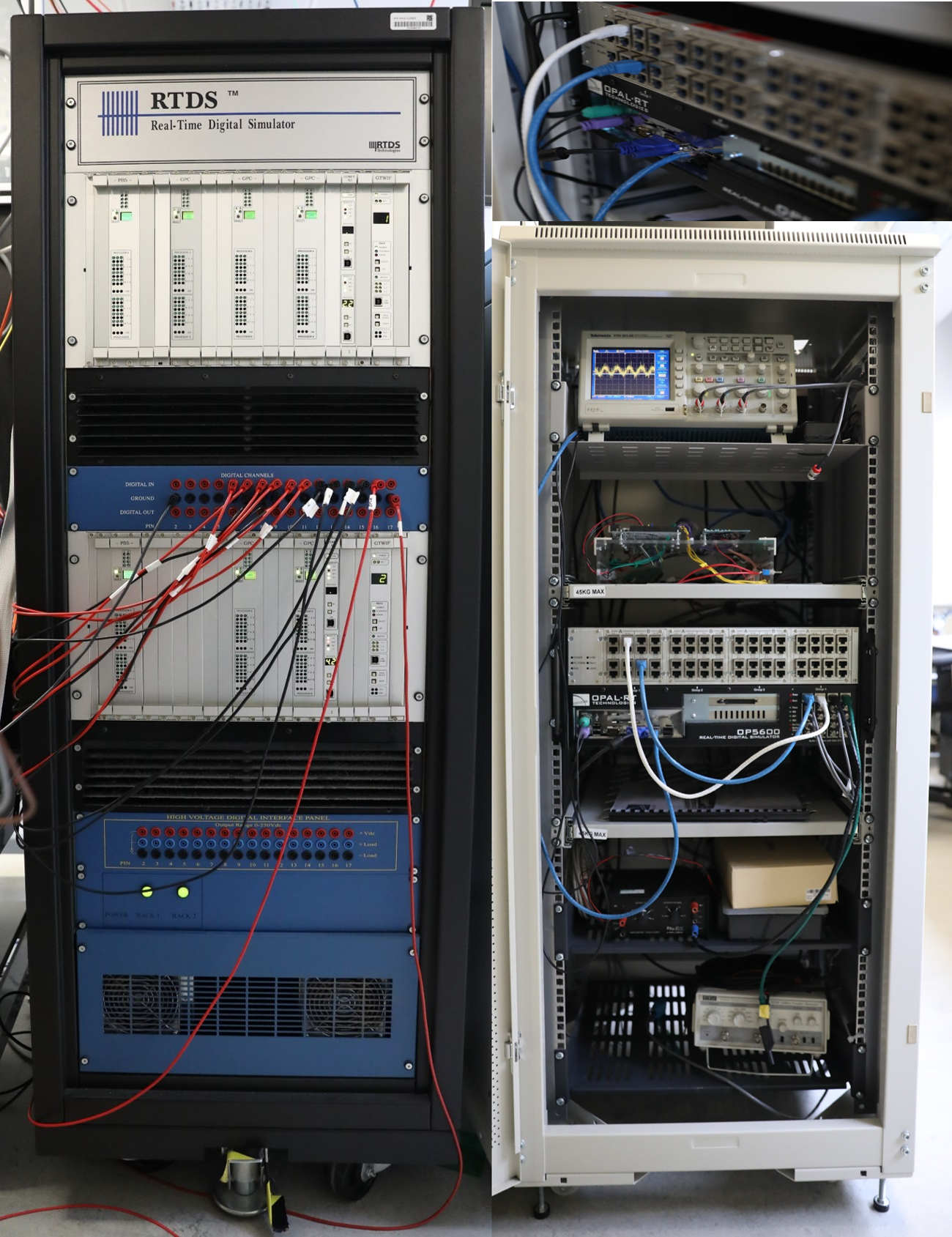
Digital Real-Time Simulation Platforms
Enabling real-time simulation of complex power systems and hardware-in-the-loop experimental validation
The laboratory has the capability to carry out real-time simulation of complex and large-scale power systems by leveraging the advanced real-time simulation platforms:
• OPAL-RT: Real-Time Simulation
• Real-Time Digital Simulator (RTDS)
• Speedgoat: Real-Time Target Machine
These state-of-the-art real-time simulation machines support the following emerging research areas:
(1) Geographically Distributed Real-Time Simulation
(2) Real-Time Controller/Power Hardware-in-the-Loop Simulation
(3) Fast Prototyping and Real-Time Testing of Novel Power Apparatus
(4) Power System Protection and Communications Emulation for Power System Applications
(5) Innovative Control Algorithms Experimental Validation to Support the Adoption of Emerging Power Converter Techniques
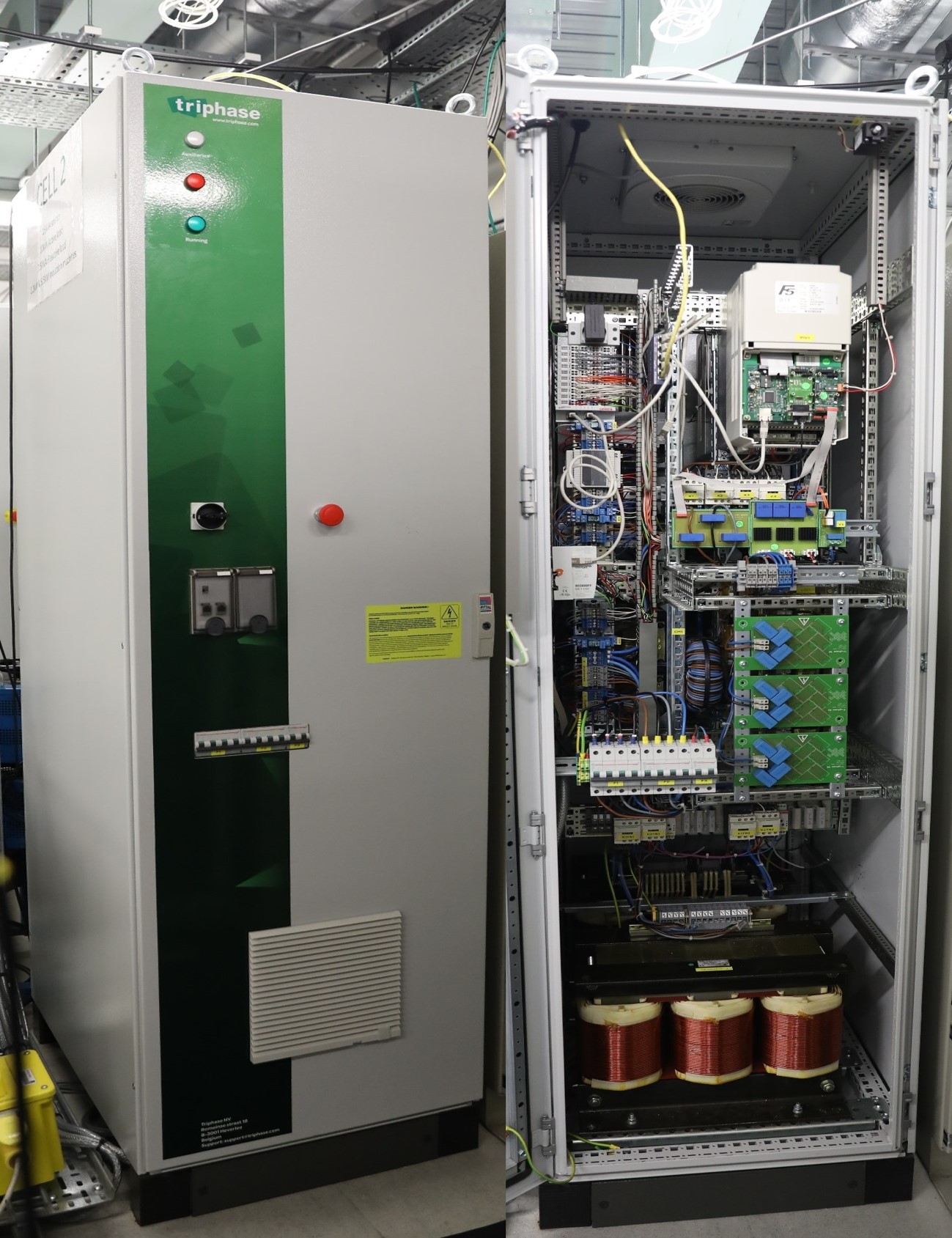
Power converter design, prototype, testing, and grid integration
Future power systems with high penetrations of converters
The laboratory has a range of power converters with flexible control systems and interfaces:
• Triphase 90kVA back-to-back power converter (grid emulator)
• Triphase 15kVA back-to-back power converter (current-mode and voltage mode)
• PELab-MMC with DAB/LLC DC-DC converters for DC microgrid application (to be installed in July/2023)
These devices are used to test and demonstrate smart grid technologies within a controlled environment, and under steady-state and abnormal conditions in a real-time operating manner. The typical research areas include but are not limited to the following:
(1) Grid-Forming Converter Testing for Black-Start Applications.
(2) Power Hardware-in-the-Loop Simulation with Single or Multiple Converters as Hardware under Test.
(3) AC, DC or Hybrid Microgrid Application (Control Scheme Validation, Energy Management, Protection, etc).
(4) Innovative Control Algorithms Experimental Validation to Support the Adoption of Emerging Power Converter Techniques.
Please refer to these links for the most recently published papers and technical reports

Microgrid setups
Realistic systems-level grid experiments (Please refer to the carousel image for the lab diagram)
The laboratory contains a reconfigurable 400 V three-phase AC/DC power network with flexible control systems and interfaces. The microgrid consists of the following:
• 2.2kW & 5.5kW induction machines
• Energy storage systems & Supercapacitor systems
• 40kW(30kVAR)-256 steps and 10kW(7.5kVAR)-64 steps dynamic load banks
• Real-time station microgrid management systems for control, monitoring and data-logging
• Triphase 15/90kVA back-to-back power converters and PELab-MMC with DAB/LLC DC-DC converters
These devices are used to test and demonstrate smart grid technologies within a controlled environment, and under steady-state and abnormal conditions in a real-time operating manner.
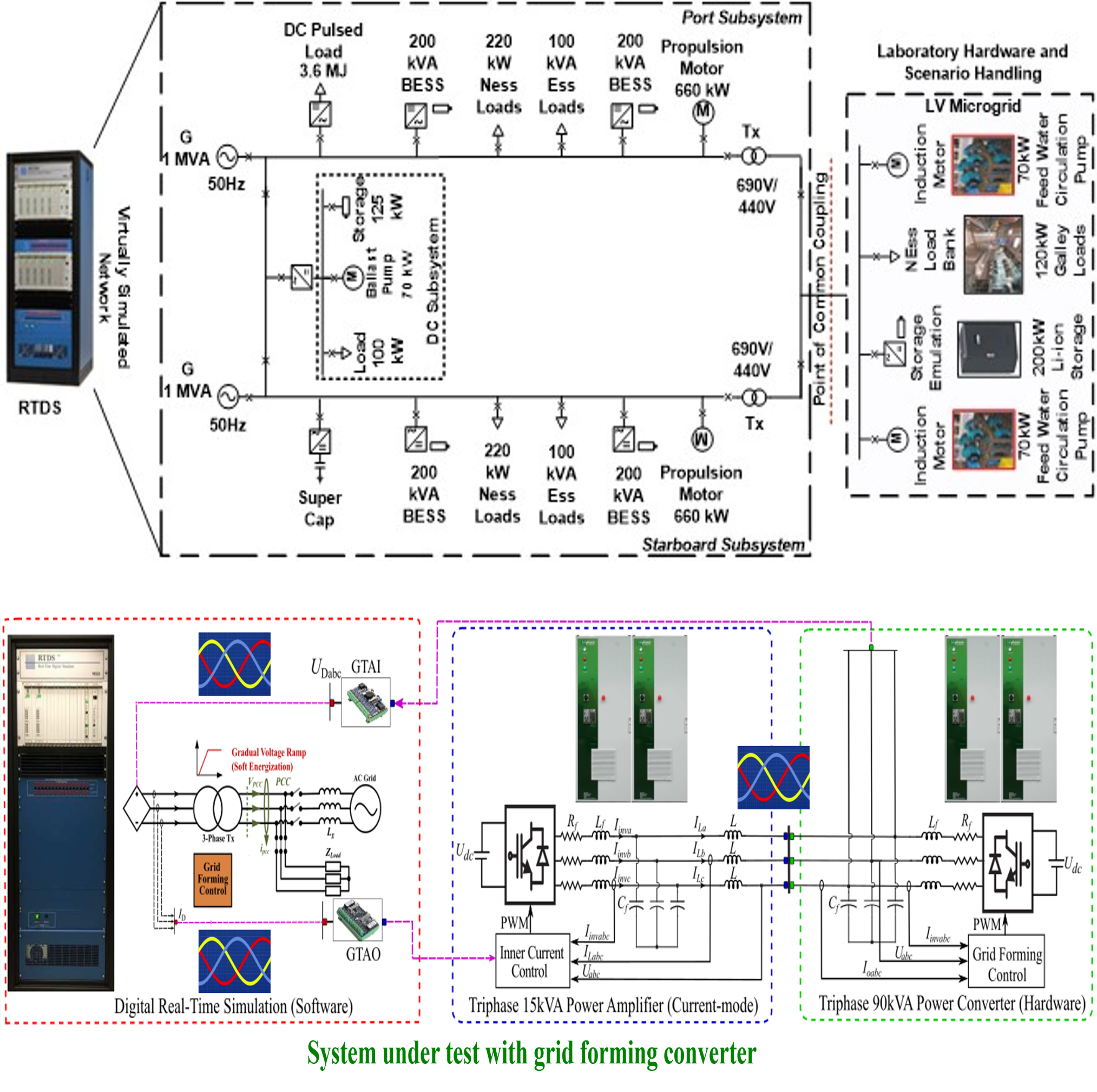
Power/Control Hardware in the Loop (P/C-HIL) validation
Realistic systems-level grid experiments
PHIL/CHIL compromises digital real-time simulation and hardware experiment into a closed-loop testing setup to enable non-destructive and in-depth investigation of the large-scale complex power systems, the candidate power apparatus, and the advanced control paradigms under broad-spectrum operation conditions. This technique has been extensively exploited for:
• Power System Education and Geographically Distributed Real-Time Co-simulation
• Verification of Novel Control Strategies for Power Systems, Microgrid, and Power Converters.
• Prototyping of Power Apparatus and Testing their Interactions with Simulated Power Networks.
• Modelling and Assessment of Renewable Energy Technologies including PV, Wind, and Energy Storage, etc.
Please refer to these links for the most recently published papers and technical reports
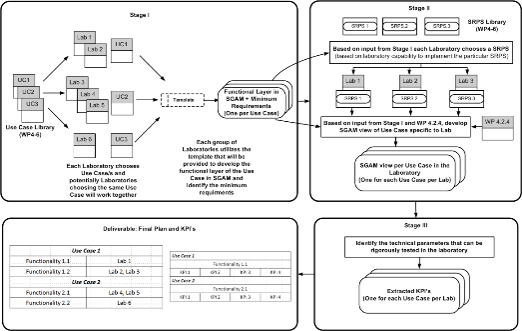
Smart Grid Architecture Model (SGAM)
Data-centric laboratory operation
The laboratory infrastructure has been mapped into the Smart Grid Architecture Model (SGAM) for facilitating the integration of devices and use cases under test. This allows for fast prototype development and minimises possible incompatibilities or integration issues.
Please refer to these links for the relevant project and most recent publications
Towards Sustainable and Safe Aviation
Controllable DC Arc Generation
Electric arc faults (high-power discharge of electricity between conductors) can develop in any electrical system. Generating heat, these faults can trigger dangerous electrical fires. In our quest to develop greener transport, we are studying the occurrence of these faults in direct current (DC) systems, aiming to assist industry in the safer development of aircraft electrification and robust protection technologies. Please refer to this link for the most recent publications
Real-time relay and controller hardware in the loop test setup
Support testing and validation of a wide range of protection and control solutions
The lab is equipped with state-of-the-art real time simulator (both RTDS and OPAL-RT). The RTDS simulator includes both conventional simulation racks and the latest NovaCor simulator. The HiL setup allows realistic testing and validation of a wide range of protection and control solutions in a flexible manner. Based on the hide-fidelity and representative benchmark RTDS network models, test configurations, along with test procedures, this experiential setup supports the following areas:
• Testing and Assessment of HVDC Systems’ Impact on AC Protection.
• Representing a Wide Range of System Operating Conditions and Future Energy Scenarios.
• Offering Insights on Potential Mitigating Actions for Improving Converter Control and/or Protection Algorithms.
Please follow the following links for more details:
Live Grid Monitoring and Visualisation Platform (LGMVP)
UK’s first open platform for visualising, recording and archiving high-resolution PMU measurements
Real-time monitoring data is critical for understanding the future energy system behaviour during the energy decarbonisation process, thus developing novel solutions for tackling renewable integration challenges. Live Grid Monitoring and Visualisation Platform (LGMVP) is the UK’s first open platform for visualising, recording and archiving high-resolution PMU measurements along with other operational data.
The LGMVP platform was developed by the University of Strathclyde in 2019, and is under continuous development and maintenance by Strathclyde.
Please follow the following links to access this LGMVP platform and get more details:
Our Team
Academic Staff
Prof Graeme Burt
Dr. Catherine Jones
Dr. Qiteng Hong
Lab Supervisor
Postdoctoral Researchers
Academic and Industrial Collaborations
Industry partners
Synaptec (UK)
National Grid (UK)
SSE Renewable (UK)
Rolls Royce (UK, USA)
Siemens (UK, German)
GE Grid Solutions (UK)
RTDS Technologies (Canada)
OPAL-RT Technologies (Canada)
National Physical Laboratory (UK)
Scottish Power Energy Networks (UK)
Beckhoff Automation Ltd (UK, Germany)
Applied Dynamics International (USA, UK)
Scottish and Southern Electricity Networks (UK)
Academic collaborators
Virginia Tech (USA)
Fraunhofer IEE (German)
Tsinghua University (China)
Imperial College London (UK)
University of Manchester (UK)
Tecnalia Research Centre (Spain)
RWTH AACHEN University (German)
Nanyang Technical University (Singapore)
Austrian Institute of Technology (Austrian)
Technical University of Denmark (Denmark)
Delft University of Technology (Netherlands)
National Technical University of Athens (Greece)
VTT Technical Research Centre of Finland (Finland)
